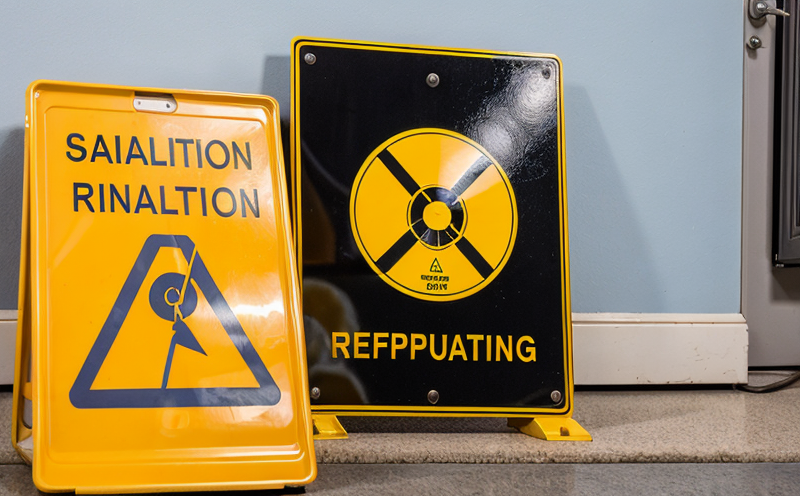ASTM E170 Calibration and Compliance Testing of Detectors
The ASTM E170 standard outlines the procedures for calibrating and assessing the performance of radiation detectors used in various industrial, medical, and research applications. This service ensures that these detectors operate within specified limits to meet regulatory requirements and safety standards.
ASTM E170 is particularly important for industries where accurate measurement of ionizing radiation is critical, such as nuclear power plants, medical facilities, and laboratories handling radioactive materials. The test involves exposing the detector to a known source of radiation and measuring its response. This process verifies that the detector provides reliable readings under controlled conditions.
Calibration using ASTM E170 ensures that detectors meet performance specifications outlined in this standard. Compliance testing is essential for maintaining operational safety, regulatory compliance, and accuracy in measurements. By adhering to this protocol, laboratories can ensure their equipment's reliability and contribute to the overall safety of personnel and environments.
The calibration process involves several steps:
- Preparation of the detector for testing
- Exposure to a standardized radiation source
- Data collection from the detector
- Analysis of the collected data against expected values
- Adjustments or recalibrations as necessary
This process is crucial in ensuring that detectors do not provide false positives or negatives, which could lead to significant safety risks. The accuracy and precision of these instruments are paramount in industries where radiation exposure must be strictly controlled.
The ASTM E170 standard also provides guidelines for the acceptance criteria used during calibration and compliance testing. These criteria ensure that only detectors meeting specific performance metrics are deemed fit for use. For instance, detectors may need to demonstrate a certain level of sensitivity or resolution under defined conditions.
By adhering to ASTM E170, laboratories can provide clients with peace of mind, knowing their instruments are accurately calibrated and compliant with industry standards. This service plays a critical role in maintaining the integrity of radiation measurement systems across diverse sectors.
Benefits
Compliance testing using ASTM E170 offers numerous advantages to clients:
- Enhanced Safety: Ensures that detectors operate within safe limits, minimizing the risk of accidental exposure to radiation.
- Regulatory Compliance: Helps facilities meet legal and regulatory requirements for radiation safety in various industries.
- Improved Accuracy: Guarantees accurate readings from detectors, which is vital for maintaining operational efficiency and reliability.
- Cost Savings: By identifying issues early through calibration and compliance testing, organizations can avoid costly downtime or accidents that could result in higher expenses.
- Informed Decision-Making: Provides clients with detailed reports on detector performance, enabling informed decisions regarding maintenance or replacement.
The benefits of ASTM E170 extend beyond immediate safety and compliance. By ensuring accurate and reliable radiation detection, this service supports the long-term sustainability and operational efficiency of facilities handling ionizing radiation.
Customer Impact and Satisfaction
Implementing ASTM E170 calibration and compliance testing has a direct positive impact on customer satisfaction. Clients can trust that their detectors are accurate, reliable, and compliant with international standards. This fosters confidence in the quality of services provided by laboratories.
- Peace of Mind: Knowing that radiation measurement systems meet stringent safety and performance criteria reduces anxiety associated with potential risks.
- Enhanced Reputation: Compliance with industry standards enhances a laboratory's reputation, attracting more clients and business opportunities.
- Informed Clients: Detailed reports provided after calibration and testing offer insights into detector performance, helping clients make informed decisions about their equipment.
- Reduced Risks: By identifying issues early, this service minimizes the risk of costly accidents or operational disruptions.
The satisfaction of customers is a key indicator of our success. By providing reliable and accurate calibration services, we ensure that clients can trust their radiation detection equipment to perform optimally under all conditions.
Environmental and Sustainability Contributions
ASTM E170 compliance testing plays a role in environmental sustainability by ensuring the safe and efficient use of ionizing radiation. By maintaining accurate detectors, facilities can minimize unnecessary exposure to radiation, reducing potential harm to both personnel and the environment.
The calibration process helps ensure that facilities use only the necessary amount of radiation for their operations, which contributes to energy efficiency and reduced waste generation. This aligns with broader sustainability goals in industries where radiation is a critical component.
By adhering to ASTM E170 standards, laboratories support sustainable practices by ensuring that their clients' equipment operates efficiently and safely. This not only enhances operational reliability but also reduces the environmental footprint associated with improper use of radiation sources.





